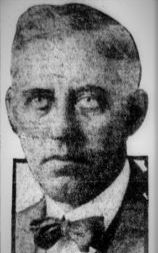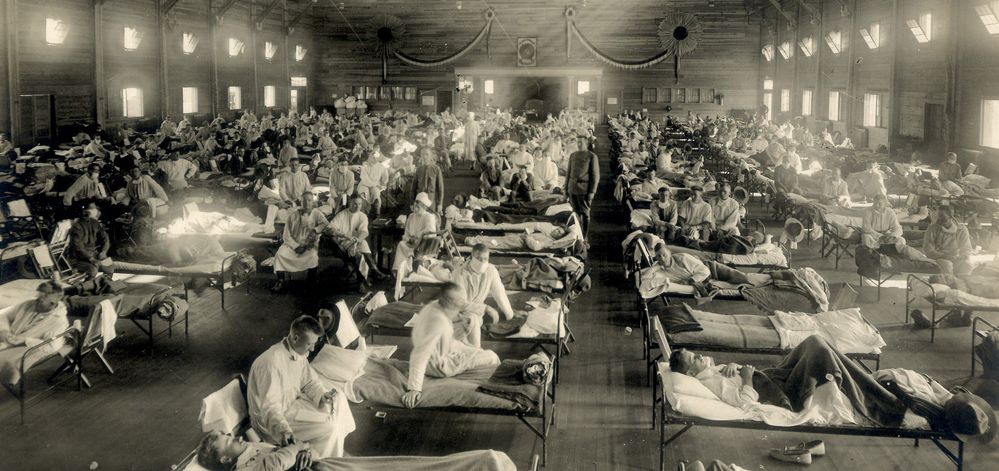Toward the end of World War I, American doctors fought an invisible enemy on the home front — a pandemic that would kill more people than any other outbreak of disease in human history.
-
Spring 2020
Volume65Issue2
Editor's Note: John Barry is the author of The Great Influenza: The Epic Story of the Deadliest Plague in History, from which this essay is adapted.

In August 1918 an influenza virus emerged — probably in the United States — and began to spread. When a young Navy doctor, Lt. John J. Keegan, saw how fast the disease moved through patients at the Chelsea Naval Hospital, he fired off a warning that it “promises to spread rapidly across the entire country, attacking between 30 and 40 percent of the population” to the Journal of the American Medical Association.
Keegan’s words proved prophetic. All over the world, the virus was adapting to humans, achieving maximum efficiency and turning lethal. Within each city, within each factory, within each family, into each store and each farm, along the length of the track of the railroads, along the rivers and roads, deep into the bowels of mines and high along the ridges of the mountains, the virus would find its way. In the next weeks, the virus would test society as a whole and each element within it. Society would have to gather itself to meet this test, or collapse.
Before that worldwide pandemic faded away in 1920, it would kill more people than any other outbreak of disease in human history. Plague in the 1300s killed a far larger proportion of the population — more than one-quarter of Europe — but in raw numbers influenza killed more than plague then, more than AIDS today..

The lowest estimate of the pandemic's worldwide death toll is twenty-one million, in a world with a population less than one-third of today's. That estimate comes from a contemporary study of the disease and newspapers have often cited it since, but it is almost certainly wrong. Epidemiologists today estimate that influenza likely caused at least fifty million deaths worldwide, and possibly as many as one hundred million.
Yet even that number understates the horror of the disease, a horror contained in other data. Normally influenza chiefly kills the elderly and infants, but in the 1918 pandemic roughly half of those who died were young men and women in the prime of their life, in their twenties and thirties. Harvey Cushing, then a brilliant young surgeon who would go on to great fame — and who himself fell desperately ill with influenza and never fully recovered from what was likely a complication — would call these victims "doubly dead in that they died so young."
One cannot know with certainty, but if the upper estimate of the death toll is true as many as 8 to 10 percent of all young adults then living may have been killed by the virus. And they died with extraordinary ferocity and speed.
When influenza kills, it usually does so in one of two ways: either quickly and directly with a violent viral pneumonia so damaging that it has been compared to burning the lungs; or more slowly and indirectly by stripping the body of defenses, allowing bacteria to invade the lungs and cause a more common and slower-killing bacterial pneumonia.
Although the influenza pandemic stretched over two years, perhaps two-thirds of the deaths occurred in a period of twenty-four weeks, and more than half of those deaths occurred in even less time, from mid-September to early December 1918. Influenza killed more people in a year than the Black Death of the Middle Ages killed in a century; it killed more people in twenty-four weeks than AIDS has killed in twenty-four years.
The influenza pandemic resembled both of those scourges in other ways also. Like AIDS, it killed those with the most to live for. And as priests had done in the bubonic plague, in 1918, even in Philadelphia, as modern a city as existed in the world, priests would drive horse-drawn wagons down the streets, calling upon those behind doors shut tight in terror to bring out their dead.
Yet the story of the 1918 influenza virus is not simply one of havoc, death, and desolation, of a society fighting a war against nature superimposed on a war against another human society.
It is also a story of science, of discovery, of how one thinks, and of how one changes the way one thinks, of how amidst near-utter chaos a few men sought the coolness of contemplation, the utter calm that precedes not philosophizing but grim, determined action.
For the influenza pandemic that erupted in 1918 was the first great collision between nature and modern science. It was the first great collision between a natural force and a society that included individuals who refused either to submit to that force or to simply call upon divine intervention to save themselves from it, individuals who instead were determined to confront this force directly, with a developing technology and with their minds.
In the United States, the story is particularly one of a handful of extraordinary people, of whom one is Paul Lewis — the scientist who later proved that a virus caused polio and then went on to develop a vaccine that protected monkeys from polio with nearly 100 percent effectiveness. Another is William Henry Welch, perhaps the single most powerful individual in the history American medicine. And Simon Flexner, the wiry and rough but brilliant head of the Rockefeller Institute.
These were men and some very few women who, far from being backward, had already developed the fundamental science upon which much of today's medicine is based. They had already developed vaccines and antitoxins and techniques still in use. They had already pushed, in some cases, close to the edge of knowledge today.
In a way, these researchers had spent much of their lives preparing for the confrontation that occurred in 1918 not only in general but, for a few of them at least, quite specifically. In every war in American history so far, disease had killed more soldiers than combat. In many wars throughout history, war had spread disease. The leaders of American research had anticipated that a major epidemic of some kind would erupt during the Great War. They had prepared for it as much as it was possible to prepare. Then they waited for it to strike.
The story, however, begins earlier. Before medicine could confront this disease with any promise of effect, it had to become scientific. It had to be revolutionized. Medicine is not yet and may never be fully a science — the idiosyncrasies, physical and otherwise, of individual patients and doctors may prevent that — but, up to a few decades before World War I, the practice of medicine had remained quite literally almost unchanged from the time of Hippocrates more than two thousand years earlier. Then, in Europe first, medical science changed and, finally, the practice of medicine changed.
But even after European medicine changed, medicine in the United States did not. In research and education especially, American medicine lagged far behind, and that made practice lag as well. While for decades European medical schools had, for example, required students to have a solid background in chemistry, biology, and other sciences, as late as 1900, it was more difficult to get into a respectable American college than into an American medical school.
At least one hundred U.S. medical schools would accept any man — but not woman — willing to pay tuition; at most 20 percent of the schools required even a high school diploma for admission — much less any academic training in science — and only a single medical school required its students to have a college degree. Nor, once students entered, did American schools necessarily make up for any lack of scientific background. Many schools bestowed a medical degree upon students who simply attended lectures and passed examinations; in some, students could fail several courses, never touch a single patient, and still get a medical degree.
Not until late — very late — in the nineteenth century, did a virtual handful of leaders of American medical science begin to plan a revolution that transformed American medicine from the most backward in the developed world into the best in the world. William James, who was a friend of — and whose son would work for — several of these men, wrote that the collecting of a critical mass of men of genius could make a whole civilization "vibrate and shake." These men intended to, and would, shake the world.
To do so required not only intelligence and training but real courage, the courage to relinquish all support and all authority. Or perhaps it required only recklessness.
Shortly before the Great War began, the men who so wanted to transform American medicine succeeded. They created a system that could produce people capable of thinking in a new way, capable of challenging the natural order. They, together with the first generation of scientists they had trained Paul Lewis and his few peers, formed a cadre who stood on alert, hoping against but expecting and preparing for the eruption of an epidemic.
When it came, they placed their lives in the path of the disease and applied all their knowledge and powers to defeat it. As it overwhelmed them, they concentrated on constructing the body of knowledge necessary to eventually triumph. For the scientific knowledge that ultimately came out of the influenza pandemic pointed directly — and still points — to much that lies in medicine's future.

